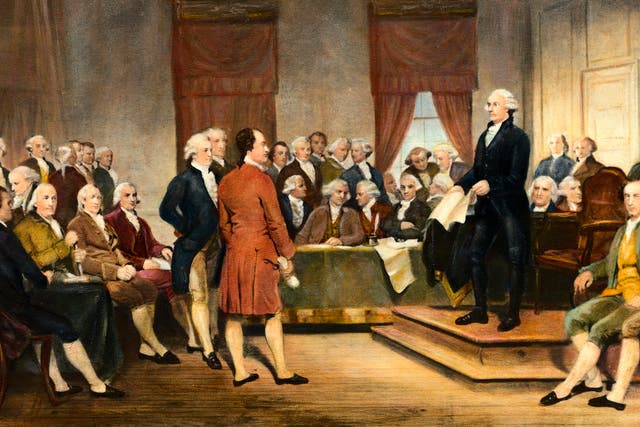

The Constitution of the United States established America’s national government and fundamental laws, and guaranteed certain basic rights for its citizens.
It was signed on September 17, 1787, by delegates to the Constitutional Convention in Philadelphia. Under America’s first governing document, the Articles of Confederation, the national government was weak and states operated like independent countries. At the 1787 convention, delegates devised a plan for a stronger federal government with three branches—executive, legislative and judicial—along with a system of checks and balances to ensure no single branch would have too much power.
History Shorts: Who Wrote the U.S. Constitution?The Preamble outlines the Constitution's purpose and guiding principles. It reads:
The Bill of Rights were 10 amendments guaranteeing basic individual protections, such as freedom of speech and religion, that became part of the Constitution in 1791. To date, there are 27 constitutional amendments.
America’s first constitution, the Articles of Confederation, was ratified in 1781, a time when the nation was a loose confederation of states, each operating like independent countries. The national government was comprised of a single legislature, the Congress of the Confederation; there was no president or judicial branch.
The Articles of Confederation gave Congress the power to govern foreign affairs, conduct war and regulate currency; however, in reality these powers were sharply limited because Congress had no authority to enforce its requests to the states for money or troops.
Seven surprising facts about the framers and the Constitutional Convention.
Since the Constitution was ratified in 1789, hundreds of thousands of bills have been introduced attempting to amend the nation's founding document. But only 27 amendments to the U.S. Constitution have been ratified.
Through amendments and legal rulings, the Constitution has transformed in some critical ways.
Beginning on December 7, 1787, five states–Delaware, Pennsylvania, New Jersey, Georgia and Connecticut–ratified the Constitution in quick succession. However, other states, especially Massachusetts, opposed the document, as it failed to reserve un-delegated powers to the states and lacked constitutional protection of basic political rights, such as freedom of speech, religion and the press.
In February 1788, a compromise was reached under which Massachusetts and other states would agree to ratify the document with the assurance that amendments would be immediately proposed. The Constitution was thus narrowly ratified in Massachusetts, followed by Maryland and South Carolina. On June 21, 1788, New Hampshire became the ninth state to ratify the document, and it was subsequently agreed that government under the U.S. Constitution would begin on March 4, 1789. George Washington was inaugurated as America’s first president on April 30, 1789. In June of that same year, Virginia ratified the Constitution, and New York followed in July. On February 2, 1790, the U.S. Supreme Court held its first session, marking the date when the government was fully operative.
Rhode Island, the last holdout of the original 13 states, finally ratified the Constitution on May 29, 1790.
In 1789, Madison, then a member of the newly established U.S. House of Representatives, introduced 19 amendments to the Constitution. On September 25, 1789, Congress adopted 12 of the amendments and sent them to the states for ratification. Ten of these amendments, known collectively as the Bill of Rights, were ratified and became part of the Constitution on December 10, 1791. The Bill of Rights guarantees individuals certain basic protections as citizens, including freedom of speech, religion and the press; the right to bear and keep arms; the right to peaceably assemble; protection from unreasonable search and seizure; and the right to a speedy and public trial by an impartial jury. For his contributions to the drafting of the Constitution, as well as its ratification, Madison became known as “Father of the Constitution.”
The first 10 amendments to the U.S. Constitution, known collectively as the Bill of Rights, became law on December 15, 1791.
The founding father worried that trying to spell out all of Americans' rights in the series of amendments could be inherently limiting.
To date, there have been thousands of proposed amendments to the Constitution. However, only 17 amendments have been ratified in addition to the Bill of Rights because the process isn’t easy–after a proposed amendment makes it through Congress, it must be ratified by three-fourths of the states. The most recent amendment to the Constitution, Article XXVII, which deals with congressional pay raises, was proposed in 1789 and ratified in 1992.
In the more than 200 years since the Constitution was created, America has stretched across an entire continent and its population and economy have expanded more than the document’s framers likely ever could have envisioned. Through all the changes, the Constitution has endured and adapted.
The framers knew it wasn’t a perfect document. However, as Benjamin Franklin said on the closing day of the convention in 1787: “I agree to this Constitution with all its faults, if they are such, because I think a central government is necessary for us… I doubt too whether any other Convention we can obtain may be able to make a better Constitution.” Today, the original Constitution is on display at the National Archives in Washington, D.C. Constitution Day is observed on September 17, to commemorate the date the document was signed.
Stream thousands of hours of acclaimed series, probing documentaries and captivating specials commercial-free in HISTORY Vault